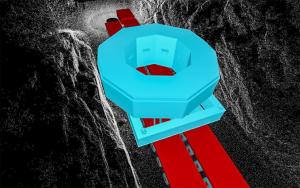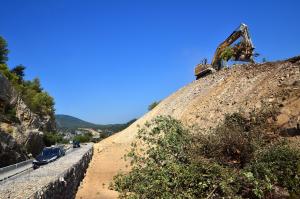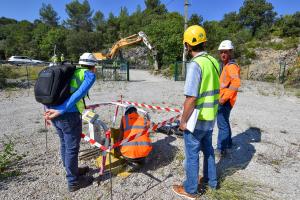Two "blocking points" were identified: a 700-metre tree-lined section of road in the nearby village of Peyrolles, and a passage between two small cliffs a few kilometres ahead of the ITER site.
Using laser measurements, 360-degree 3D scanning and "point cloud" extraction, DAHER experts captured the precise topography of both sites, inserted a 3D model of the load sitting on its trailer, and produced an animated real-scale virtual rendition of the passage of the PF6 convoy.
In the case of the tree-lined road, the degree of precision achieved by DAHER made it possible to identify every single branch that could potentially stand in the way of the convoy, decide which ones needed to be pruned, and plot an adapted slalom course for the trailer.
The same techniques were applied to the cliff passage in order to minimize the amount of rock and vegetation to be removed, and hence the cost of the operation.
Performed between 16 July and 9 August, the rock removal operation faced one additional challenge: operators needed to ensure that the vibrations generated by the excavators did not impact the concrete structure of the old water canal running under the road.
Vibration frequencies and acceleration were monitored by an array of sensors, sending real-time information to all parties involved. At no time did the works threaten the integrity of the canal—a strategic waterway that powers a nearby hydro-electric plant and delivers drinking water to the city of Marseille.
By 9 August, 1,700 cubic metres of rock had been removed and the vertical cliff cut to a 40-degree slant. The road is now open for the largest and most delicate elephants to be delivered to ITER: not only poloidal field coil #6, but also, beginning next year, the 18 toroidal field coils (10 metres wide, 17 metres high) that will also be able to travel in a flat position.
¹ According to Roman historians Polybius and Titus Livius, Hannibal, faced with a huge boulder blocking his way, had a pyre amassed around the stone and set afire. When the rock was red-hot and began fissuring, he had vinegar poured into the cracks. The chemical reaction between the hot limestone and the acetic acid contained in the vinegar accelerated the fracturing process. Using crowbars and wedges, sappers were then able to slit the rock and pry it to pieces.




